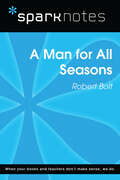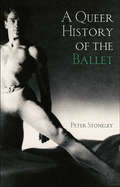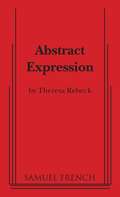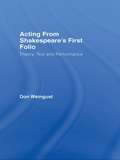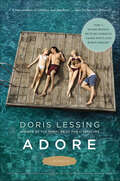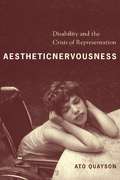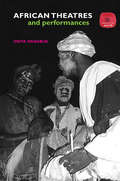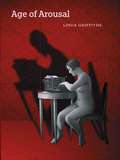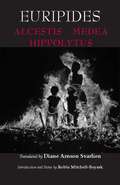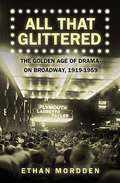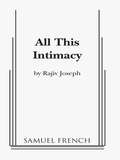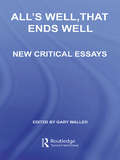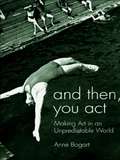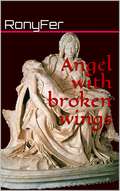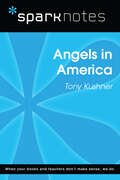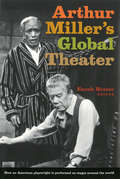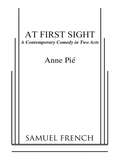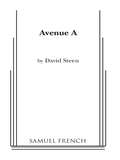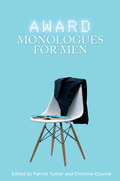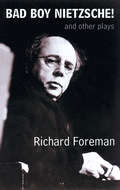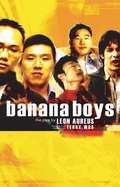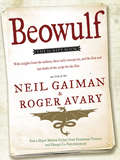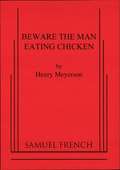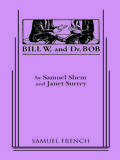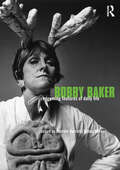- Table View
- List View
A Man for All Seasons (SparkNotes Literature Guide Series)
by SparkNotesA Man for All Seasons (SparkNotes Literature Guide) by Robert Bolt Making the reading experience fun! Created by Harvard students for students everywhere, SparkNotes is a new breed of study guide: smarter, better, faster. Geared to what today's students need to know, SparkNotes provides: *Chapter-by-chapter analysis *Explanations of key themes, motifs, and symbols *A review quiz and essay topicsLively and accessible, these guides are perfect for late-night studying and writing papers
A Queer History of the Ballet
by Peter StoneleyDesigned for students, scholars and general readers with an interest in dance and queer history, A Queer History of the Ballet focuses on how, as makers and as audiences, queer men and women have helped to develop many of the texts, images, and legends of ballet. Presenting a series of historical case studies, the book explores the ways in which, from the nineteenth century into the twentieth, ballet has been a means of conjuring homosexuality – of enabling some degree of expression and visibility for people who were otherwise declared illegal and obscene. Studies include: the perverse sororities of the Romantic ballet the fairy in folklore, literature, and ballet Tchaikovsky and the making of Swan Lake Diaghilev’s Ballets Russes and the emergence of queer modernity the formation of ballet in America the queer uses of the prima ballerina Genet’s writings for and about ballet. Also including a consideration of how ballet’s queer tradition has been memorialized by such contemporary dance-makers as Neumeier, Bausch, Bourne, and Preljocaj, this is an essential book in the study of ballet and queer history.
Abstract Expressions
by Theresa RebeckAfter a scathing review 15 years ago, a once-celebrated painter faded into impoverished obscurity. Can one chance encounter resurrect this volatile artist from obscurity and re-launch him to overnight success? Theresa Rebeck skillfully compares the gritty urban realities of lives lived on the edge with the capricious intrigues of the uptown gallery scene where fame might just be a matter of who you know and reputations can be bought and sold.
Acting from Shakespeare's First Folio: Theory, Text and Performance
by Don WeingustActing from Shakespeare's First Folio examines a series of techniques for reading and performing Shakespeare's plays that are based on the texts of the first ‘complete’ volume of Shakespeare's works: the First Folio of 1623. Do extra syllables in a line suggest how it might be played? Can Folio commas reveal character? Don Weingust places this work on Folio performance possibility within current understandings about Shakespearean text, describing ways in which these challenging theories about acting often align quite nicely with the work of the theories' critics. As part of this study, Weingust looks at the work of Patrick Tucker and his London-based Original Shakespeare Company, who have sought to discover the opportunities in using First Folio texts, acting techniques, and what they consider to be original Shakespearean performance methodologies. Weingust argues that their experimental performances at the Globe on Bankside have revealed enhanced possibilities not only for performing Shakespeare, but for theatrical practice in general.
Adore: A Novella
by Doris Lessing“A keen sociological eye for class and ideology; an understanding of the contradictory impulses of the human heart; an ability to conjure a place, a mood and a time through seemingly matter-of-fact descriptions.” — Michiko Kakutani, New York TimesShocking, intimate, often uncomfortably honest, Adore reaffirms Doris Lessing’s unrivaled ability to capture the truth of the human condition.Roz and Lil have been best friends since childhood. But their bond stretches beyond familiar bounds when these middle-aged mothers fall in love with each other's teenage sons—taboo-shattering passions that last for years, until the women end them, vowing to have a respectable old age.
Aesthetic Nervousness: Disability and the Crisis of Representation
by Ato QuaysonFocusing primarily on the work of Samuel Beckett, Toni Morrison, Wole Soyinka, and J. M. Coetzee, Ato Quayson launches a thoroughly cross-cultural, interdisciplinary study of the representation of physical disability. Quayson suggests that the subliminal unease and moral panic invoked by the disabled is refracted within the structures of literature and literary discourse itself, a crisis he terms "aesthetic nervousness." The disabled reminds the able-bodied that the body is provisional and temporary and that normality is wrapped up in certain social frameworks. Quayson expands his argument by turning to Greek and Yoruba writings, African American and postcolonial literature, depictions of deformed characters in early modern England and the plays of Shakespeare, and children's films, among other texts. He considers how disability affects interpersonal relationships and forces the character and the reader to take an ethical standpoint, much like representations of violence, pain, and the sacred. The disabled are also used to represent social suffering, inadvertently obscuring their true hardships.
African Theatres and Performances
by Osita OkagbueAfrican Theatres & Performances looks at four specific performance forms in Africa and uses this to question the tendency to employ western frames of reference to analyze and appreciate theatrical performance. The book examines: masquerade theatre in Eastern Nigeria the trance and possession ritual theatre of the Hausa of Northern Nigeria the musical and oral tradition of the Mandinka of Senegal comedy and satire of the Bamana in Mali. Osita Okagbue describes each performance in detail and discusses how each is made, who it is made by and for, and considers the relationship between maker and viewer and the social functions of performance and theatre in African societies. The discussions are based on first-hand observation and interviews with performers and spectators. African Theatres & Performances gives a fascinating account of these practices, carefully tracing the ways in which performances and theatres are unique and expressive of their cultural context.
Age of Arousal
by Linda GriffithsIt's a time of passion and confusion. Virtue is barely holding down its petticoats. People are bursting their corsets with unbridled desire. It's 1885, and the typewriter and the suffrage movement are sending things topsy-turvy. In the midst of it all, five ambitious New Women and one Newish Man struggle to find their way. Miss Mary Barfoot runs a school for secretaries with her young lover, Miss Rhoda Nunn. But when the Misses Madden spinsters Virginia and Alice and beautiful young Monica arrive, along with the attractive Dr. Everard Barfoot, things can never be the same.Age of Arousal is a lavish, sexy, frenetic ensemble piece about the forbidden and gloriously liberated self genre-busting, rule-bending, and ambitiously original. The book includes notes and a rousing, thoughtful essay on Victorian womens' suffrage by the playwright.'Endlessly witty, vigorous, funny... brilliantly inventive.' - Calgary Herald 'Griffiths is one of Canada's 'originals' known not only for the quality of her work, but for the sheer range of her career.' - Maclean's
Alcestis, Medea, Hippolytus
by Euripides Diane Arnson Svarlien Robin Mitchell-BoyaskThis new volume of three of Euripides' most celebrated plays offers graceful, economical, metrical translations that convey the wide range of effects of the playwright's verse, from the idiomatic speech of its dialogue to the high formality of its choral odes.
All That Glittered
by Ethan MorddenFrom the late 1920s to late 1950s, the Broadway theatre was America's cultural epicenter. Television didn't exist and movies were novelties. Entertainment took the form of literature, music, and theatre. During this golden age of Broadway, actors and actresses became legends and starred in now classic plays. Laurence Olivier, Alfred Lunt and Lynne Fontaine were names to remember, etching plays into memory as they brought the words of Tennessee Williams or Eugene O'Neill to life. Joseph Cotton romanced Katherine Hepburn in Philip Barry's The Philadelphia Story while Laurette Taylor became The Glass Menagerie's Amanda Wingfield. Frederic March, Florence Eldridge, Jason Robards Jr. and Bradford Dillman showed us life among the ruins in Long Day's Journey Into Night. In All That Glittered, Ethan Mordden, long one of Broadway's best chroniclers, recreates the fascinating lost world of its golden age.
All This Intimacy
by Rajiv JosephDramatic Comedy / Characters: 2 male, 4 female / Unit Set. / Ty Greene is a normal guy with three very big problems. In an unprecedented (for him) run of promiscuity, Ty has managed to impregnate three women in the span of one week: His ex-girlfriend, his 40-something married next-door neighbor, and his 18 year-old student. In this edgy comedy by playwright Rajiv Joseph, Ty's problems illuminate every triumph and failure of his life, and as the women in his world converge and figure out what's happened, Ty realizes that his life is adrift, and that he only has a limited time to try to piece it back together. All This Intimacy, which according to The New York Times has "a certain can't-look-away pull," is a comedy about friendship and lust and how the two don't mix. . "**** FOUR STARS! It's the best show I've seen in months! It's one worth catching!" -Matt Windman, amNY . "HAS A CAN'T-LOOK-AWAY PULL!" -The New York Times . "RIFE WITH GENUINE FUN & PINPOINTS OF POIGNANCY!" -Broadway.com . "A VERY BRAVE TOUCH WITH CHARACTERS & THEMES!" - New York Sun . "VERY FINE WRITING!" -TheaterMania.com
All's Well, That Ends Well: New Critical Essays (Shakespeare Criticism)
by Gary WallerDescribed as one of Shakespeare’s most intriguing plays, All’s Well That Ends Well has only recently begun to receive the critical attention it deserves. Noted as a crucial point of development in Shakespeare’s career, this collection of new essays reflects the growing interest in the play and presents a broad range of approaches to it, including historical, feminist, performative and psychoanalytical criticisms. In addition to fourteen essays written by leading scholars, the editor’s introduction provides a substantial overview of the play’s critical history, with a strong focus on performance analysis and the impact that this has had on its reception and reputation. Demonstrating a variety of approaches to the play and furthering recent debates, this book makes a valuable contribution to Shakespeare criticism.
And Then, You Act: Making Art in an Unpredictable World
by Anne BogartFrom well-known auteur of the American theatre scene, Anne Bogart, And Then, You Act is a fascinating and accessible book about directing theatre, acting and the collaborative creative process. Writing clearly and passionately, Bogart speaks to a wide audience, from undergraduates to practitioners, and makes an invaluable contribution to the field tackling themes such as: intentionality inspiration why theatre matters. Following on from her successful book A Director Prepares, which has become a key text for teaching directing classes, And Then, You Act is an essential practitioner and student resource.
Angel with broken wings
by Ronyfer Federico RenziStories of struggle and perseverance of one of the many political refugees who had to leave their Latin American country to try their luck in one of the countries called "first world". Juan Ramon emigrated from his native Guatemala to take refuge with his wife Flor de Maria, escaping from the institutionalized repression, to face the cold and xenophobic Canadian society.Then; he suffers, as so many thousands of displaced and dispossessed who have lost everything. Or almost everything; because it perseverance, courage, love of life and capacity for solidarity is.
Angels in America (SparkNotes Literature Guide Series)
by SparkNotesAngels in America (SparkNotes Literature Guide) by Tony Kushner Making the reading experience fun! Created by Harvard students for students everywhere, SparkNotes is a new breed of study guide: smarter, better, faster.Geared to what today's students need to know, SparkNotes provides:*chapter-by-chapter analysis *explanations of key themes, motifs, and symbols *a review quiz and essay topics Lively and accessible, these guides are perfect for late-night studying and writing papers.
Arthur Miller's Global Theater
by Enoch BraterNo American playwright is more revered on the international stage than Arthur Miller. In Arthur Miller’s Global Theater—a fascinating collection of new essays by leading international critics and scholars—readers learn how and why audiences around the world have responded to the work of the late theatrical icon. With perspectives from diverse corners of the globe, from Israel to Japan to South Africa, this groundbreaking volume explores the challenges of translating one of the most American of American playwrights and details how disparate nations have adapted meaning in Miller’s most celebrated dramas. An original and engaging collection that will appeal to theater aficionados, scholars, students, and all those interested in Miller and his remarkable oeuvre, Arthur Miller’s Global Theater illustrates how dramas such as Death of a Salesman, The Crucible, and A View from the Bridge developed a vigorous dialogue with new audiences when they crossed linguistic and national borders. In these times when problems of censorship, repressive regimes, and international discord are increasingly in the news, Arthur Miller’s voice has never been more necessary as it continues to be heard and celebrated around the world.
At First Sight
by Anne PiéComedy / 3m, 4f / Fifty-one year old Julia Goldman thought she had experienced it all. Although she had been widowed for two years, she was left financially well-fixed with two grown children who were busy with their successful careers. Life was routine and uneventful for Julia in her Hollywood home. She thought she would just ease into the rest of her days without anything notable looming on the horizon. Suddenly, "Life with a Capital L" hands her what is to become the biggest decision of her life; the sort of occurrence to which many a younger woman would hardly be equal. An accidental encounter in the cocktail lounge of a posh hotel with a man who sweeps her off her feet and then disappears, leaves her with much more than just a fond memory. She is no longer able to conceal her predicament. The sibling rivalry of her children, plus her own with her flamboyant sister, Verna, add to the complexity, and to the resolution of her plight.
Avenue A
by David SteenFull Length \ Dark Dramatic Comedy \ 3m, 1f \ Various Settings/Unit Set \ Described as "a sideways look at the American dream," Avenue A is the gripping tale of an ex-con struggling to create his own family of misfits as an old prison buddy mysteriously returns for one final visit. It is a carefully crafted and mordantly funny look at rebirth amidst urban decay. Avenue A has been greeted with tremendous praise from audiences and critics alike. \ "A frayed nerve of a drama...poke your head in and take a long sickening look at the freaks." The New York Times
Award Monologues for Men
by Patrick Tucker Christine OzanneAward Monologues for Men is a collection of fifty monologues taken from plays written since 1980 that have been nominated for the Pullitzer Prize, the Tony and the Drama Desk Awards in New York, and The Evening Standard and Laurence Olivier Awards in London. The book provides an excellent range of up-to-date audition pieces, usefully arranged in age groups, and is supplemented with audition tips to improve your acting, and to ensure you give your best possible performance.
Bad Boy Nietzsche! and Other Plays
by Richard ForemanRichard Foreman has been at the leading edge of the theatrical avant-garde in the United States and throughout the world since 1968. His legendary productions, written and directed by him at his Ontological-Hysteric Theatre have influenced two generations of theater artists. This new anthology collects plays written and performed over six years, including Now That Communism Is Dead My Life Feels Empty, Maria del Bosco, Panic (How to Be Happy!), Bad Boy Nietzsche!, Bad Behavior and King Cowboy Rufus Rules the Universe.Richard Foreman founded the Ontological-Hysteric Theatre in 1968. The theater is currently in the historic St. Marks Church, where he rehearses and produces one of his new plays each year, each play performing for 16 weeks every winter.
Banana Boys: The Play
by Leon AureusA smart, contemporary, and wickedly funny play about five young Asian Canadian men wrestling with issues of race, identity, and the death of a friend. Banana Boys is one story, fragmented into five and reconstructed throughout the course of the lives of the five young men it follows. Adapted from the novel by Terry Woo, Banana Boys is a “meditation for the restless” and a call to anyone who has felt out of place in the world.
Beowulf
by Neil Gaiman Roger AvaryWho will come to the aid of beleaguered King Hrothgar, whose warriors have become the prey of the vengeful outcast monster Grendel?In the able hands of #1 New York Times bestselling author Neil Gaiman (Anansi Boys, American Gods) and Academy Award-winning screenwriter Roger Avary (Pulp Fiction, Silent Hill), a timeless classic adventure takes on a astonishing new life. Here are the initial draft and final shooting script of the star-studded blockbuster film from Paramount Pictures and Academy Award-winning director Robert Zemeckis (Forest Gump, Back to the Future), plus concept art, fascinating insights in the screenplay's evolution, an introduction by Avary, an afterword from Gaiman...AND MUCH, MUCH MORE!
Beware the Man Eating Chicken
by Henry MeyersonFarce / 2m, 3f, with doubling / Betty, wanting to be a good mother to her son William, devises a plan to Make Him Bigger and Make Him a Winner. She enters William in the “Fattest Man in the Universe†contest, and she is determined to win. Carole, Betty’s younger sister, too weak to stand up to Betty’s threats and intimidation, is forced to assist in the endless round of cooking the dozens of chickens needed each day for William’s inexorable assault on hugeness. When Captain Leonard of the Board of Health comes to check on the “large carnivore†that is devouring twenty chickens a day he is initially an annoying bureaucrat, but ultimately a timely dessert. Albert, claiming to own one of the largest chicken farms in the U.S. arrives to negotiate a deal. For using William’s picture on the logo of his product Albert will pay Betty a percentage of the profits on each bird sold and ancillary rights on tie-ins. The deal is struck. When Dorothy, Albert’s sister, appears claiming she is the true owner of the chicken farm, a struggle between the siblings ensues for control of William and the potential fortune at stake. But it is Doctor Martin who brings the tragic coup de grace to Betty and her plan for achieving her goals of motherhood."Henry Meyerson's one-act is a classic, well-constructed, three-door farce. Its subtext may be a critique of American capitalism, but Meyerson keeps the complaint subtle and focuses instead on recognizable family dynamics: The situation is inherently absurd, but the characters all act with their own skewed logic." - Columbus Dispatch"Edgy...shocking...uncomfortably funny and bizarre...outrageous black-as-midnight comedy...sublimely ridiculous end result of being enormously entertaining." - The Times-Standard, Eureka, CA“Think The Honeymooners meets Little Shop of Horrors…fans of theatre, even vegetarians, should make a hearty meal of this superlative evening…headlong romp…edgy absurdity and laugh-out-loud humor†– The North Coast Journal, Eureka, CAFee: $75 per performance.Other Henry Meyerson titles available from Samuel French include: Fresh Brewed Shtick Proceed to Checkout
Bill W. and Dr. Bob
by Samuel Shem Janet SurreyDrama / 3m, 3f (w/doubling) / Unit set Newly revised edition! From the author of the best-selling novel, The House of God, this critically acclaimed version which played Off-Broadway in 2007, tells the amazing story of the two men who pioneered Alcoholics Anonymous, and of their wives, who founded Al Anon. During the roaring '20s, New York stockbroker Bill Wilson rides high on money, fame, and booze. In '29, both he and the market crash and he becomes a hopeless drunk. Dr. Bob Smith, a surgeon in Akron, Ohio, and a pillar of the community, has been a secret drunk for thirty years, often going into the operating room hungover and high on sedatives. His family has tried everything to no avail. Through an astonishing series of events involving doctors, ministers, the Oxford Group evangelical movement, and Henrietta Sieberling a scion of the Goodyear Rubber fortune, Bill and Bob meet on Mother's Day of 1935. The two men form a relationship which keeps each sober. Fired up, they seek out a third drunk to see if their program will work for others. Richly textured with the ragtime and jazz of the era, the play tells a magnificent American success story. "A deeply human, audience embracing tale." - Variety "One of the best plays of the year." - San Diego Union Tribune "Inspiring." - Boston Globe
Bobby Baker: Redeeming Features of Daily Life
by Michèle Barrett Bobby BakerBobby Baker is one of most widely acclaimed and popular performance artists working today. Over the course of a thirty-five-year career she has toured the globe with her wildly stimulating explorations of 'Daily Life' and has been extensively written about and studied. This fully-illustrated book brings together for the first time an account of Baker's career as an artist – from her first sculptures at Central St Martins in the early 1970s to her most recent work, 'How to Live' and 'Diary Drawings' – with critical commentary by reviewers and academic practitioners. It includes: Bobby Baker's own 'Chronicle' of her work as artist and performer illuminating critical writing about Baker's shows transcripts of Baker's performances and other original materials reproduced here for the first time significant new essays by Michele Barrett and Griselda Pollock a new interview with Bobby Baker by Adrian Heathfield. Under the guiding editorial hand of distinguished cultural theorist Michèle Barrett, this volume is an essential text for students interested in performance, gender, and visual culture, and a hugely absorbing and accessible account of Baker's work.
